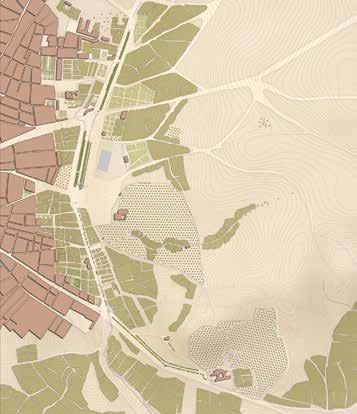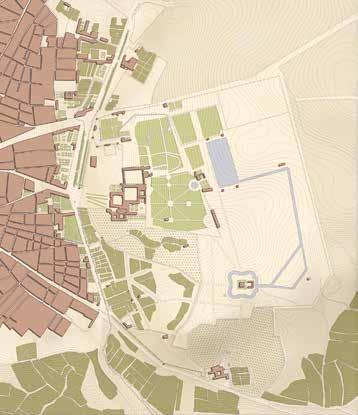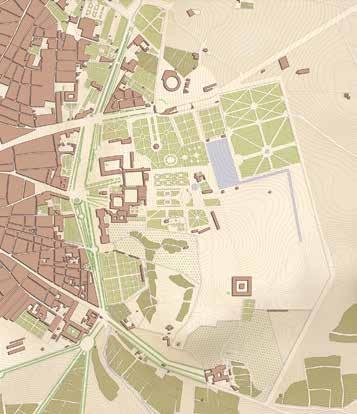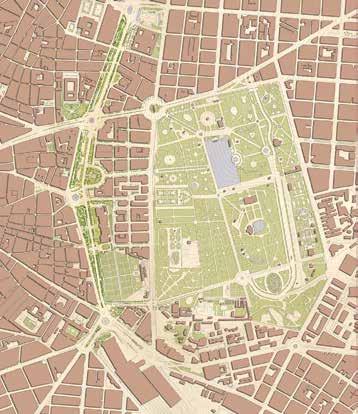
4 minute read
Historia y evolución
c. 1570
La secuencia se inicia con el estado del Prado a mediados del siglo XVI. La vaguada, con su arroyo flanqueado por alineaciones de árboles, y la presencia de algunas fuentes para el disfrute ciudadano. Aparecen también los primeros conventos allí establecidos desde los inicios del siglo, San Jerónimo y Atocha, así como las posesiones con casas, huertas y jardines que conformaban las laderas del conjunto; entre ellas discurrían los caminos que comunicaban la nueva capital con las poblaciones próximas situadas al oriente de la misma.
Advertisement
c. 1650
La gran transformación del lugar se produce por la imponente aparición del conjunto del palacio y jardines del Buen Retiro; este ocupará la totalidad de la ladera oriental de la vaguada y la meseta escarpada hacia el sur sobre el convento de Atocha. Sobre ella se dispone el gran estanque para espectáculos y la serie de ermitas ajardinadas con diversas advocaciones que albergaban el disfrute de fiestas, de carácter mixto entre lo religioso y lo lúdico.
c. 1570 The sequence begins with a recreation of the state of the site towards the mid-16th century. It represents the El Prado streambed with its stream flanked by trees, and the presence of some fountains for the enjoyment of the citizenry. We can also see the first convents that were built there in the early years of the century, San Jeronimo and Atocha, as well as the properties consisting of houses, orchards and gardens that occupied the slopes. The roads that communicated the new capital with nearby towns located to the east ran through this area.
c. 1650 The great transformation of the site took place thanks to the imposing structure of the palace and gardens of the Buen Retiro, which would occupy the whole of the eastern slope of the area and the rugged plateau to the south above the Convento de Atocha (convent of Atocha). A large pond was built to stage events as well as a series of landscaped and dedicated hermitages that catered for celebrations that combined religious and festive elements.


c. 1800
A partir de 1767, el ámbito incorpora la fundamental transformación ilustrada con la nueva conformación del Prado; esta discurre desde la puerta de Recoletos a la de Atocha, conseguida con nuevas alineaciones de árboles y las fuentes de Cibeles, Apolo y Neptuno formando el nuevo Salón del Prado. Sobre esta base se comienzan a disponer las dotaciones científicas fundamentales del Jardín Botánico y el Laboratorio Químico así como el nuevo Observatorio astronómico y el Hospital General, un proyecto de Francesco Sabatini, prototipo de hospital moderno. Al mismo tiempo, se han abierto al uso público parte de los jardines del Buen Retiro, gozando el conjunto de una notable intensificación del uso ciudadano.
c. 1875
En 1850 había aparecido en la zona sur la estación del ferrocarril de Atocha, que condicionará el devenir urbanístico del ámbito en relación con la inminente desaparición del antiguo convento de Atocha. Por las mismas fechas hay que destacar la nueva presencia del Congreso de Diputados. Aprobado el proyecto de ensanche, y comenzando a segregarse los terrenos del antiguo conjunto en su parte oriental, con el nuevo trazado de la calle de Granada, hoy Alfonso XII, en este momento el antiguo conjunto ajardinado es ya de propiedad y gestión municipal, denominándose ahora Parque de Madrid. Como recuerdo un tanto equívoco, parte de la antigua huerta de San Juan se denomina ahora Jardines del Retiro, albergando algo parecido a un parque de atracciones, en la ubicación del actual Ayuntamiento.
c. 1800 After 1767, the area incorporated key Enlightened changes with the new layout of El Prado; it now ran from Puerta de Recoletos (Recoletos Gate) to the Atocha Gate, and included new lines of trees and the Cibeles, Apolo and Neptune fountains, forming the new Salon del Prado. This is the basis on which the key scientific facilities of the Real Jardín Botánico and the Laboratorio Químico were built, not forgetting the new Real Observatorio Astronómico and the General Hospital, a project by Francesco Sabatini, the prototype of a modern hospital. At the same time, part of the Buen Retiro was opened to the public, with the subsequent intensification of their use by the citizens.
c. 1875 In 1850, the Estación de Atocha (Atocha Railway Station) was built in the southern section. This affected the future urban development of the area in relation to the imminent disappearance of the former convent of Atocha. In the same period, we must stress the new building of the Congreso de los Diputados (Congress of Deputies). Part of the land was to be developed and urbanised, west from the new calle de de Alfonso XII. Soon after the ownership of the ancient gardens passed to the city council and for a time the Buen Retiro was called Park of Madrid. Only a small area conserved the name of Buen Retiro Gardens, housing what could be considered an amusement park, in the current location of the Ayuntamiento de Madrid.


c. 1935
En el estado previo a la Guerra Civil, se ha consolidado el nuevo ensanche al norte del área. En la Colina de las Ciencias aparecen nuevas dotaciones científicas y educativas como es el caso de la Escuela de Ingenieros de Caminos, allí establecida desde 1885, y las dotaciones docentes de la Institución Libre de Enseñanza. En el ámbito del Prado destaca la progresiva presencia institucional con la sede de la Bolsa de Comercio, el Palacio de Comunicaciones y la sede del Ministerio de Marina. En el parque caben destacar las nuevas construcciones de los palacios de exposiciones y del monumento a Alfonso XII en el estanque.
2020
Finalmente, el Paisaje de la Luz en su estado actual, resultado de las transformaciones históricas que han consolidado sus vínculos con las Artes y Ciencias. Constituye un área privilegiada de naturaleza en el centro de la ciudad, que se ha convertido en un espacio imprescindible en la vida de los ciudadanos madrileños y de todos los visitantes que acuden a conocer los tesoros que encierra.
c. 1935 The plan reflects the state of the site prior to the civil war. On Science Hill, new scientific and educational facilities are being built, such as the Escuela de Ingenieros (Civil Engineering School) established since 1885, and the premises of the Institución Libre de Enseñanza (Free Institution of Education). In the Prado, we must mention an increasing institutional presence with the headquarters of the Bolsa de Madrid (Stock Market), the Palacio de Comunicaciones (Palace of Communications), and the headquarters of the Ministerio de Marina (Ministry of the Marine). Within the park, there are new constructions, such as the Palacio de Cristal and Palacio de Velazquez for exhibitions and the monument to Alfonso XII in the lake.
2020 Finally, the Landscape of Light in its current state, as result of the historical transformations that have consolidated its links with the Arts and Sciences. It is a privileged area of nature in the center of the city, which has become an essential space in the life of the citizens of Madrid and of all the visitors who come to discover its hidden treasures.





